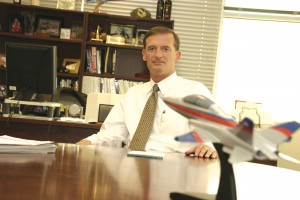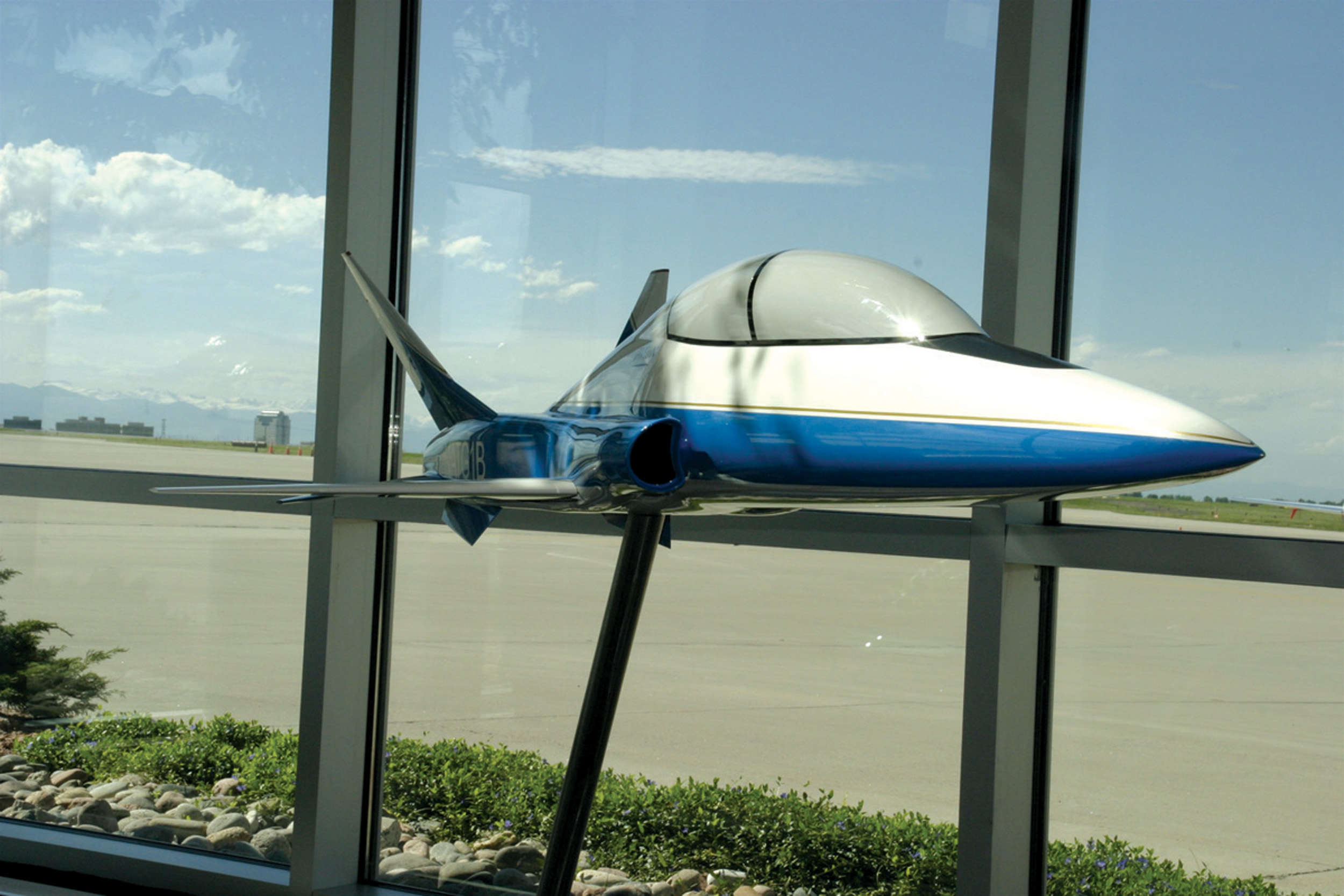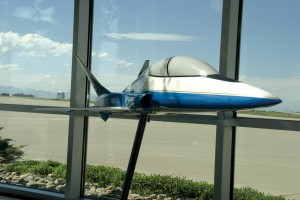By Jeff Mattoon
If one compares the new VLJ (very light jet) aircraft to cars, what we have is a whole new category of sports cars. That is, all except for one, which is more like an Indy racer than a luxury sports car.
According to Aviation Technology Group, they’re just several weeks away from first flight of their Javelin prototype, heralding a super-high performance adrenalin junkie’s dream flying machine.
George Bye, company founder, CEO and retired military pilot, is very clear about the design origins of this VLJ: the Javelin is meant to look and handle like a sleek military jet trainer, but without the hundred-plus million-dollar price tag.
If you’re a retired military fast-jet pilot or you like the idea of flying their toys, Bye asks, “How about a fifth-generation, state-of-the-art military trainer available to the civil market under FAR 23 using all the VLJ economies and technologies, but with the performance of a military airplane?”
Compared to other VLJ products, it sounds like a pretty narrow niche market—and it is. With other manufacturers projecting hundreds of units per year, Bye says the ATG business plan is quite comfortable with 400 units sold over the 10-year period following certification, which is now estimated at late 2007.
So, the nagging question is, with a $2.75 million price tag and room for only two, who would buy such a beast? Apparently plenty of people, one of whom is Larry Barels.
With a lifestyle that resembles Jimmy Buffett’s, without the singing, 56-year-old Barels amusingly suggests that each morning he gets to wake up and do pretty much what he wants, when he wants. Having taken two companies public, which as he says is the business equivalent of winning the lottery, he now acts as an investor, investment advisor and chairman of the board, without day-to-day responsibilities. This fits nicely into all sorts of activities, including surfing, skiing and sailing. In fact, in mid-June, Barels was preparing for the 2005 TransPacific Yacht Race, from Long Beach, Calif., to Hawaii.
“Retired? You need something to do!”
When Barels told his friends he was retiring, none of them believed he could to do it successfully.
“A lot of people think that if you’re successful with a company, it’s because you’re a good manager,” he said. “They assume that’s what you enjoy (most) and that must mean that you won’t be fulfilled unless you’re managing people, but it’s really the creativity and the visionary aspect of the job that interests and excites me.”
Once Barels began telling friends and acquaintances that he was retired, they assumed he needed something to do. How wrong they were. Spending over 100 days per year traveling with his wife and residing in Mammoth, Calif., for three months of the year, the last thing this resident of Santa Barbara, Calif., needed was something to do.
Barels laughs, “They offered me work with their favorite charities and with other businesses (as a consultant), so I had business cards made up that say I’m a ‘Professional Recreationalist.’ I told them that I stay real busy with my job.”
One of his “jobs” is flying his Extra 300, performing aerobatics. He also owns a Citation CJ-1 and a King Air, and has over 25 years flying experience.
Some years back, Barels wanted more performance with his aerobatics—the performance of a jet. He had already checked into warbirds, but the expense of maintenance and their inefficient guzzling of fuel made that option not very attractive.
“Buying an older aircraft and keeping it running is a real problem,” comments Barels. “You’d probably need to have someone on staff and you’re also probably looking at three to five hours of a mechanic’s time for every hour you’re in the air.”
When the VLJ buzz started, he thought there might be a solution there, but quickly learned that path was probably not for him either.
“From an aerobatic perspective, the performance of VLJs is pretty anemic,” says Barels. That is, until he learned about the Javelin.
“There’s no way you can make it!”
In late 2002, Barels flew down to Orange County in the King Air for a business meeting.
“There happened to be a display of light business jets near where I tied down,” recalled Barels. “Sitting beside one of them was a mock-up of the most beautiful general aviation airplane I had ever seen. It was called the Javelin.”
Hs first thought was, “There’s no way you can make it.”
“It’s going to cost you close to $150 million to build the first one and how are you going to sell enough to justify that production cost?” he thought. “So I had a chat with George Bye. I thought from his enthusiasm and confidence that he just might make it happen.”
Within 72 hours of seeing the aircraft, Barels had a more detailed discussion with Bye resulting in a deposit on the twenty-fifth production aircraft. Unlike the other leading light jets in the new category, until now, if one wanted to see a Javelin, all interested parties could do was look at either computer-generated models and various-sized mock-ups or fly in the state-of-the-art Javelin flight simulator. Not much excitement, or so it seemed.
“The Javelin will be the fastest civil-certified aircraft in the world. It will go right to FL45 at Mach .92 with unparalleled economy. It will have the fuel economy of an Eclipse, but at around 150 more knots of speed,” beams Bye.
To VLJ or not to VLJ?
Another thing Bye is quick to point out is that though the Javelin is technically a VLJ, the company is really not competing in that market. The criticisms of a much smaller niche market are actually complements in the ears of the ATG crowd.
“When we get a deposit, it’s purposeful. They know, up front, it’s not a six-passenger VLJ. I’m not at risk for being traded for an (Adam) A700 or an Eclipse. When they give me their money, it’s for a Javelin, period—not a VLJ,” states Bye.
Getting back to the question of how ATG can afford to build the aircraft, there are two answers: faith and the military. Remember ATG’s 10-year sales goal of 400 civil aircraft? To date, there are over 100 deposits on George Bye’s hot rod of the heavens. In other words, 25 percent of a decade’s goal is met before the plane has ever flown. That’s the faith part and that makes Bye and everyone at ATG smile.
Since Bye made the first hand drawing of what would become the Javelin back in 1998, he already had the answer to Larry Barels’ question of how the company could afford such production costs. In Bye’s mind now, and from the beginning, the Javelin is first and foremost a military trainer. The ultimate market for the Javelin will be the U.S. military and the military of its allies.
“When an aircraft is launched in the U.S. military, it’s launched with a gigantic budget from Congress,” he said. “We’re doing something very special and very unique. Our aircraft is justified in the civil market under FAR Part 25 certification. The number of aircraft required to justify production have already been exceeded, so when we brief friends and allies around the world and they ask for a number of airplanes we say, ‘Sign here; we can do that.'”
Civil application funds military R&D
According to Bye, the non-civil applications for the Javelin are nearly endless. Military trainers, homeland defense, search and rescue, reconnaissance patrolling—there are all types of applications for this platform. Because of dual-use, ATG is able to build its markets incrementally; Bye believes eventually the military or non-civil market will exceed the general aviation market, but it’s that GA market that affords them the ability to develop the military market.
As far as Bye is concerned, getting to the military market will come soon, but in its own time. From his estimation, the GA market is plenty large enough.
“There are over 70,000 military T-38 trained ex-fast-jet pilots like me, most whom got out of the military and got their ATP,” he said. “They went to work for the airlines flying the silver bus from Chicago to Seattle and back ten times a month. What I do, and what I love to do are two different things. What I do is monitor systems on a 757; what I love to do is turn and burn and do aerobatics and fly fast in an airplane that looks and feels like the jet I used in my military career.”
Bye also suggests a certain portion of those pilots can afford the Javelin and a larger portion still can afford to partner with a small group of comrades and turn and burn to their hearts’ content. That may be true, but it appears there is a healthy non-military market interested in the Javelin. Bye is quick to agree, and adds that many of those are people who, for whatever reason, could not, or would not enter military flight training, but still have an interest in military-style aircraft.
Overstock.com

ATG President & CEO George Bye is confident the Javelin will find a successful niche in the VLJ market.
One of those people is 42-year-old Patrick Byrne, CEO and founder of Overstock.com, an Internet-based, below-retail store.
Byrne comes from a flying family where his father, retired from the Air Force, and his two older brothers all fly, but only the senior Byrne has military training.
Byrne started flying young and now holds multi-engine, instrument, and sea plane ratings, and has logged 1,100 hours. Growing up mostly in New Hampshire and Vermont, he took the traditional route of flight training by starting small and working his way up. He went from a Cessna 150 to a 172, and spent some time in a Grumman Cheetah and a Piper Navaho, but the plane he most admired was a Lake Amphibian Turbo Renegade.
At one point he worked for a company located right on the local airport. On Fridays during the summer, he would get off work, walk over to his plane, fly to a lake somewhere, put the gear down and drive up to shore for a weekend of camping and fishing. On Monday, he drove the Renegade back into the water, took off, flew back to New Hampshire and went back to work.
When the Overstock.com opportunity came about in 1999, he moved to Utah where he traded in the slow-flying Lake for shares in NetJets and Flight Options. He had now hit the big time. Last year, Overstock.com grossed about $500 million in sales. This year, Byrne expects to be close to $1 billion and his long-range goal is to surpass Amazon.com in gross sales.
Byrne’s most common trips are from Salt Lake City to Los Angeles, San Francisco, Boston, New York and Miami; since he hasn’t flown for a number of years now, he has the itch to get back to piloting.
His interest in the Javelin was purely accidental. For a few years, Byrne has looked all over the Internet for a warbird that would fulfill his missions, but was disappointed.
“I figured I would buy some warbird and hire a full-time retired military pilot,” he said. “The problem with that idea was most of those airplanes only have a range of about 500 miles, so you would have to refuel a couple of times on a trip to New York.”
Then a couple of years ago on a trip to Colorado, Byrne saw the mock-up of the Javelin outside the Signature FBO at Centennial Airport.
Like brother, like brother
Byrne said the mock-up really caught his eye.
“When I got home, I looked it up on the Internet, but didn’t see any meaningful specs, so I put it out of my mind,” he said. “Then about four months ago, my brother Mark called me to ask if I had ever seen a new plane called the Javelin.”
Mark Byrne is an investment manager and runs an investment fund in Bermuda. He carries a pilot’s license for every category and class of aircraft except blimps. He has three jet type ratings for his Falcon 900, Westwind. and King Air (which is a jet-type in England). He also carries English and Swiss airman’s licenses.
“While I have access to several planes, all of them are a lot bigger than what I need most of the time to go back and forth to the U.S. for business meetings,” he said. “The Javelin will free up the larger planes for charter operations, so think of it as a corporate aircraft fleet. We have a 12 passenger, six passenger and now we’ll have a one passenger (plus pilot).”
When asked why the Javelin and not some other VLJ was his choice, he had already carefully considered the answer.
“I don’t think there’s anything close for the mission—for transporting one or two people efficiently up to 1,000 miles with its capability and operating cost,” Mark Byrne said. He’s quick to add, “I’ll admit the styling and aerobatic characteristics will make it a lot of fun to fly, but those are secondary to the mission.”
It’s clear that Mark Byrne takes his flying and flight training seriously, and he hopes that all pilots entering the VLJ category and specifically the Javelin will be equally serious. He trains at FlightSafety four times per year and is concerned that other pilots who don’t take training seriously might cause insurance rates for the aircraft to climb.
ATG is concerned about training too.
“We have an intense amount of focus on training. We have very highly qualified pilots in our test organization and they’re helping to develop our training program,” says ATG COO Charlie Johnson.
Johnson’s name is quickly recognized in the world of general aviation. Prior to joining forces with ATG, he was president of Cessna, where he started in 1979 and retired in 2003. Prior to that, he was chief of production flight test for Gates Lear Jet. After flying F-105s in the Air Force in Vietnam, he was hired as Arnold Palmer’s chief pilot. Now Johnson is tasked with transforming ATG from a small entrepreneurial company to a conventional aerospace manufacturing organization.
“We’re talking to major training companies right now that will offer an emerging program in the VLJ world based on the pilot’s experience,” he said.
The program will offer basic aircraft, weather, physiology, extensive systems training and for those who want it, aerobatic training.
Insurance reasonable
This attention to the demands for training is showing an early benefit. Johnson is very pleased with preliminary insurance rate estimations for the Javelin. Training and the small passenger limit is certainly a factor, but the typical pilot for this type of aircraft bears its influence.
“The vast majority of people who can afford this type of aircraft are the type of people who understand investing and the ramifications of everything they do; they’re not the type of people who throw all caution to the wind,” observes Johnson. “Many of our customers have experience with flying high performance aircraft in the military and many of them intend on flying with a second pilot, some indefinitely and some for a period of time before solo.”
Both Byrne brothers now have deposits on the Javelin and both intend on using a second pilot. Their missions are similar in that they both intend on using the Javelin as primary business transportation, with a little fun on the side. Larry Barels, on the other hand, is going another route.
“My range with the Javelin will be something like British Columbia, Denver and Cabo (San Lucas, Mexico), which I travel to fairly frequently,” he said. “I can’t wait to see the guys in Cabo when I fly in on the Javelin; it’s going to be fun.”
Maybe advertisements for the Javelin should use “Vroom, vroom” as their slogan.
For more information on the Javelin, visit [http://www.avtechgroup.com].













